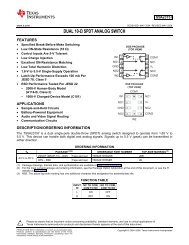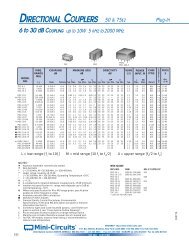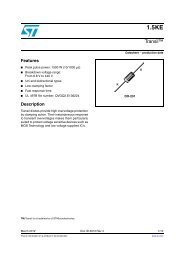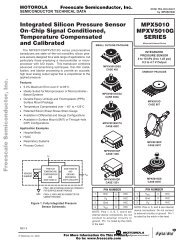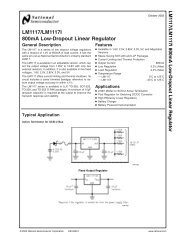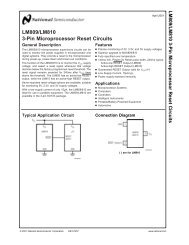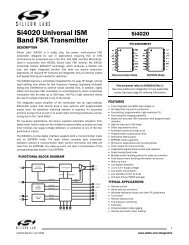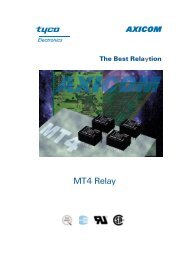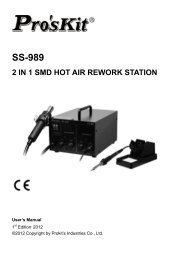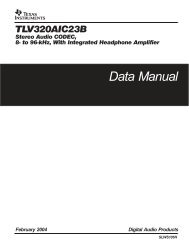LT3467/LT3467A APPLICATIO S U DESCRIPTIO U FEATURES ...
LT3467/LT3467A APPLICATIO S U DESCRIPTIO U FEATURES ...
LT3467/LT3467A APPLICATIO S U DESCRIPTIO U FEATURES ...
Create successful ePaper yourself
Turn your PDF publications into a flip-book with our unique Google optimized e-Paper software.
<strong>FEATURES</strong><br />
■ 1.3MHz Switching Frequency (<strong>LT3467</strong>)<br />
■ 2.1MHz Switching Frequency (<strong>LT3467</strong>A)<br />
■ Low V CESAT Switch: 330mV at 1.1A<br />
■ High Output Voltage: Up to 40V<br />
■ Wide Input Range: 2.4V to 16V<br />
■ Dedicated Soft-Start Pin<br />
■ 5V at 540mA from 3.3V Input (<strong>LT3467</strong>)<br />
■ 5V at 430mA from 3.3V Input (<strong>LT3467</strong>A)<br />
■ 12V at 270mA from 5V Input (<strong>LT3467</strong>)<br />
■ 12V at 260mA from 5V Input (<strong>LT3467</strong>A)<br />
■ Uses Small Surface Mount Components<br />
■ Low Shutdown Current:
<strong>LT3467</strong>/<strong>LT3467</strong>A<br />
ABSOLUTE AXI U RATI GS<br />
(Note 1)<br />
W W W<br />
V IN Voltage .............................................................. 16V<br />
SW Voltage ................................................–0.4V to 42V<br />
FB Voltage .............................................................. 2.5V<br />
Current Into FB Pin .............................................. ±1mA<br />
SHDN Voltage ......................................................... 16V<br />
U<br />
Maximum Junction Temperature ......................... 125°C<br />
Operating Temperature Range (Note 2) .. –40°C to 85°C<br />
Storage Temperature Range ................. –65°C to 150°C<br />
Lead Temperature (Soldering, 10 sec,<br />
TSOT Only) ........................................................... 300°C<br />
U W<br />
PACKAGE/ORDER I FOR ATIO<br />
U<br />
TOP VIEW<br />
ORDER PART<br />
NUMBER<br />
ORDER PART<br />
NUMBER<br />
FB<br />
GND<br />
SW<br />
SW<br />
1<br />
2<br />
3<br />
4<br />
T JMAX = 125°C, θ JA = 80°C/ W<br />
9<br />
DDB PACKAGE<br />
8-LEAD (3mm × 2mm) PLASTIC DFN<br />
8<br />
7<br />
6<br />
5<br />
SHDN<br />
SS<br />
V IN<br />
GND<br />
<strong>LT3467</strong>EDDB<br />
<strong>LT3467</strong>AEDDB<br />
DFN PART<br />
MARKING<br />
SW 1<br />
GND 2<br />
FB 3<br />
TOP VIEW<br />
S6 PACKAGE<br />
6-LEAD PLASTIC TSOT-23<br />
6 V IN<br />
5 SS<br />
4 SHDN<br />
T JMAX = 125°C, θ JA = 165°C/ W, θ JC = 102°C/ W<br />
<strong>LT3467</strong>ES6<br />
<strong>LT3467</strong>AES6<br />
S6 PART<br />
MARKING<br />
EXPOSED PAD (PIN 9) IS GROUND<br />
(MUST BE SOLDERED TO PCB)<br />
LCPX<br />
LCKD<br />
LTACH<br />
LTBCC<br />
Order Options Tape and Reel: Add #TR<br />
Lead Free: Add #PBF Lead Free Tape and Reel: Add #TRPBF<br />
Lead Free Part Marking: http://www.linear.com/leadfree/<br />
Consult LTC Marketing for parts specified with wider operating temperature ranges.<br />
2<br />
3467afb
ELECTRICAL CHARACTERISTICS<br />
<strong>LT3467</strong>/<strong>LT3467</strong>A<br />
The ● denotes specifications which apply over the full operating<br />
temperature range, otherwise specifications are T A = 25°C. V IN = 3V, V SHDN = V IN unless otherwise noted. Specifications are for both<br />
the <strong>LT3467</strong> and <strong>LT3467</strong>A unless otherwise noted.<br />
PARAMETER CONDITIONS MIN TYP MAX UNITS<br />
Minimum Operating Voltage 2.2 2.4 V<br />
Maximum Operating Voltage 16 V<br />
Feedback Voltage 1.230 1.255 1.270 V<br />
● 1.220 1.280 V<br />
FB Pin Bias Current (Note 3) ● 10 50 nA<br />
Quiescent Current V SHDN = 2.4V, Not Switching 1.2 2 mA<br />
Quiescent Current in Shutdown V SHDN = 0.5V, V IN = 3V 0.01 1 µA<br />
Reference Line Regulation 2.6V ≤ V IN ≤ 16V 0.01 0.05 %/V<br />
Switching Frequency <strong>LT3467</strong> 1 1.3 1.6 MHz<br />
<strong>LT3467</strong>A 1.6 2.1 2.7 MHz<br />
<strong>LT3467</strong>A ● 1.6 MHz<br />
Maximum Duty Cycle <strong>LT3467</strong> 88 94 %<br />
<strong>LT3467</strong> ● 87 %<br />
<strong>LT3467</strong>A 82 88 %<br />
<strong>LT3467</strong>A ● 78 %<br />
Minimum Duty Cycle 10 %<br />
Switch Current Limit At Minimum Duty Cycle 1.4 1.8 2.5 A<br />
At Maximum Duty Cycle (Note 4) 0.8 1.2 1.9 A<br />
Switch V CESAT I SW = 1.1A 330 500 mV<br />
Switch Leakage Current V SW = 5V 0.01 1 µA<br />
SHDN Input Voltage High 2.4 V<br />
SHDN Input Voltage Low 0.5 V<br />
SHDN Pin Bias Current V SHDN = 3V 16 32 µA<br />
V SHDN = 0V 0 0.1 µA<br />
SS Charging Current V SS = 0.5V 2 3 4.5 µA<br />
Note 1: Stresses beyond those listed under Absolute Maximum Ratings<br />
may cause permanent damage to the device. Exposure to any Absolute<br />
Maximum Rating condition for extended periods may affect device<br />
reliability and lifetime.<br />
Note 2: The <strong>LT3467</strong>E/<strong>LT3467</strong>AE are guaranteed to meet performance<br />
specifications from 0°C to 85°C. Specifications over the –40°C to 85°C<br />
operating temperature range are assured by design, characterization and<br />
correlation with statistical process controls.<br />
Note 3: Current flows out of the pin.<br />
Note 4: See Typical Performance Characteristics for guaranteed current<br />
limit vs duty cycle.<br />
3467afb<br />
3
<strong>LT3467</strong>/<strong>LT3467</strong>A<br />
TYPICAL PERFOR A CE CHARACTERISTICS<br />
UW<br />
I Q (mA)<br />
1.6<br />
1.4<br />
1.2<br />
1.0<br />
0.8<br />
0.6<br />
0.4<br />
0.2<br />
Quiescent Current vs<br />
Temperature FB Pin Voltage vs Temperature SHDN Current vs SHDN Voltage<br />
V FB (V)<br />
1.26<br />
1.25<br />
1.24<br />
1.23<br />
1.22<br />
1.21<br />
I SHDN (µA)<br />
140<br />
120<br />
100<br />
80<br />
60<br />
40<br />
20<br />
T A = 25°C<br />
0<br />
–40 –25 –10 5 20 35 50 65 80 95 110 125<br />
TEMPERATURE (°C)<br />
1.20<br />
–40 –25 –10 5 20 35 50 65 80 95 110 125<br />
TEMPERATURE (°C)<br />
0<br />
0<br />
2 4 6 8 10 12 14 16 18<br />
V SHDN (V)<br />
3467 G01<br />
3467 G02<br />
3467 G03<br />
I LIM (A)<br />
Current Limit vs Duty Cycle<br />
2.0<br />
T A = 25°C<br />
1.8<br />
1.6<br />
TYPICAL<br />
1.4<br />
1.2<br />
GUARANTEED<br />
1.0<br />
0.8<br />
0.6<br />
0.4<br />
V CESAT<br />
100mV<br />
/DIV<br />
Switch Saturation Voltage vs<br />
Switch Current<br />
T A = 85°C<br />
T A = 25°C<br />
T A = –40°C<br />
OSCILLATOR FREQUENCY (MHz)<br />
2.50<br />
2.25<br />
2.00<br />
1.75<br />
1.50<br />
1.25<br />
1.00<br />
0.75<br />
0.50<br />
Oscillator Frequency vs<br />
Temperature<br />
<strong>LT3467</strong><br />
<strong>LT3467</strong>A<br />
0.2<br />
0.25<br />
0<br />
10<br />
20 30 40 50 60 70 80 90<br />
DC (%)<br />
SW CURRENT 200mA/DIV<br />
3467 G05<br />
0<br />
–50<br />
–25 0 25 50 75<br />
TEMPERATURE (°C)<br />
100<br />
3467 G04<br />
3467 G06<br />
Soft-Start Current vs Soft-Start<br />
Voltage<br />
Peak Switch Current vs Soft-Start<br />
Voltage<br />
Start-Up Waveform<br />
(Figure 2 Circuit)<br />
I SS (µA)<br />
6<br />
5<br />
4<br />
3<br />
2<br />
T A = 25°C<br />
SWITCH CURRENT (A)<br />
2.0<br />
1.8<br />
1.6<br />
1.4<br />
1.2<br />
1.0<br />
0.8<br />
0.6<br />
T A = 25°C<br />
V SHDN<br />
2V/DIV<br />
V OUT<br />
1V/DIV<br />
1<br />
0.4<br />
0.2<br />
I SUPPLY<br />
0.5A/DIV<br />
0<br />
0 50 100 150 200 250 300 350 400 450 500<br />
V SS (mV)<br />
0<br />
0 50 100 150 200 250 300 350 400 450 500<br />
V SS (mV)<br />
0.5ms/DIV<br />
3467 G09<br />
3467 G07<br />
3467 G08<br />
4<br />
3467afb
<strong>LT3467</strong>/<strong>LT3467</strong>A<br />
PI FU CTIO S<br />
U U U<br />
(DFN/TSOT)<br />
FB (Pin 1/Pin 3): Feedback Pin. Reference voltage is<br />
1.255V. Connect resistive divider tap here. Minimize trace<br />
area at FB. Set V OUT = 1.255V(1 + R1/R2).<br />
GND (Pins 2, 5, 9/Pin 2): Ground. Tie directly to local<br />
ground plane.<br />
SW (Pins 3, 4/Pin 1): Switch Pin. (Collector of internal<br />
NPN power switch) Connect inductor/diode here and<br />
minimize the metal trace area connected to this pin to<br />
minimize EMI.<br />
V IN (Pin 6/Pin 6): Input Supply Pin. Must be locally<br />
bypassed.<br />
SS (Pin 7/Pin 5): Soft-Start Pin. Place a soft-start capacitor<br />
here. Upon start-up, 4µA of current charges the capacitor<br />
to 1.255V. Use a larger capacitor for slower start-up.<br />
Leave floating if not in use.<br />
SHDN (Pin 8/Pin 4): Shutdown Pin. Tie to 2.4V or more to<br />
enable device. Ground to shut down.<br />
BLOCK DIAGRA<br />
W<br />
250k<br />
SS<br />
V IN<br />
V OUT<br />
1.255V<br />
REFERENCE<br />
+<br />
–<br />
A1<br />
R C<br />
C C<br />
–<br />
+<br />
COMPARATOR<br />
A2<br />
R<br />
S<br />
Q<br />
DRIVER<br />
–<br />
+<br />
Q1<br />
SW<br />
R1 (EXTERNAL)<br />
FB<br />
R2 (EXTERNAL)<br />
Σ<br />
RAMP<br />
GENERATOR<br />
0.01Ω<br />
SHUTDOWN<br />
SHDN<br />
FB<br />
GND<br />
1.3MHz<br />
OSCILLATOR*<br />
*2.1MHz FOR <strong>LT3467</strong>A<br />
3467 F01<br />
Figure 1. Block Diagram<br />
3467afb<br />
5
<strong>LT3467</strong>/<strong>LT3467</strong>A<br />
OPERATIO U<br />
The <strong>LT3467</strong> uses a constant frequency, current-mode<br />
control scheme to provide excellent line and load regulation.<br />
Refer to the Block Diagram above. At the start of each<br />
oscillator cycle, the SR latch is set which turns on the<br />
power switch Q1. A voltage proportional to the switch<br />
current is added to a stabilizing ramp and the resulting<br />
sum is fed into the positive terminal of the PWM comparator<br />
A2. When this voltage exceeds the level at the negative<br />
input of A2, the SR latch is reset, turning off the power<br />
switch. The level at the negative input of A2 is set by the<br />
error amplifier A1, and is simply an amplified version of the<br />
difference between the feedback voltage and the reference<br />
voltage of 1.255V. In this manner, the error amplifier sets<br />
the correct peak current level to keep the output in regulation.<br />
If the error amplifier’s output increases, more<br />
current is delivered to the output. Similarly, if the error<br />
decreases, less current is delivered. The soft-start feature<br />
of the <strong>LT3467</strong> allows for clean start-up conditions by<br />
limiting the rate of voltage rise at the output of comparator<br />
A1 which, in turn, limits the peak switch current. The softstart<br />
pin is connected to a reference voltage of 1.255V<br />
through a 250k resistor, providing 4µA of current to<br />
charge the soft-start capacitor. Typical values for the softstart<br />
capacitor range from 10nF to 200nF. The <strong>LT3467</strong> has<br />
a current limit circuit not shown in the Block Diagram. The<br />
switch current is constantly monitored and not allowed to<br />
exceed the maximum switch current (typically 1.4A). If the<br />
switch current reaches this value, the SR latch is reset<br />
regardless of the state of comparator A2. This current limit<br />
protects the power switch as well as the external components<br />
connected to the <strong>LT3467</strong>.<br />
The Block Diagram for the <strong>LT3467</strong>A (not shown) is<br />
identical except that the oscillator frequency is 2.1MHz.<br />
<strong>APPLICATIO</strong>NS INFORMATION<br />
U W U U<br />
Duty Cycle<br />
The typical maximum duty cycle of the <strong>LT3467</strong> is 94%<br />
(88% for the <strong>LT3467</strong>A). The duty cycle for a given<br />
application is given by:<br />
| V V V<br />
DC<br />
OUT | + |<br />
=<br />
D |–| IN |<br />
| V | + | V |–| V |<br />
OUT D CESAT<br />
Where V D is the diode forward voltage drop and V CESAT<br />
is in the worst case 330mV (at 1.1A)<br />
The <strong>LT3467</strong> and <strong>LT3467</strong>A can be used at higher duty<br />
cycles, but must be operated in the discontinuous conduction<br />
mode so that the actual duty cycle is reduced.<br />
Setting Output Voltage<br />
R1 and R2 determine the output voltage.<br />
Switching Frequency and Inductor Selection<br />
The <strong>LT3467</strong> switches at 1.3 MHz, allowing for small valued<br />
inductors to be used. 4.7µH or 10µH will usually suffice.<br />
The <strong>LT3467</strong>A switches at 2.1MHz, allowing for even<br />
smaller valued inductors to be used. 0.9µH to 6.8µH will<br />
usually suffice. Choose an inductor that can handle at least<br />
1.2A without saturating, and ensure that the inductor has<br />
a low DCR (copper-wire resistance) to minimize I 2 R power<br />
losses. Note that in some applications, the current handling<br />
requirements of the inductor can be lower, such as<br />
in the SEPIC topology where each inductor only carries<br />
one half of the total switch current. For better efficiency,<br />
use similar valued inductors with a larger volume. Many<br />
different sizes and shapes are available from various<br />
manufacturers. Choose a core material that has low losses<br />
at 1.3 MHz, (2.1MHz for the <strong>LT3467</strong>A) such as ferrite core.<br />
V OUT = 1.255V (1+ R1/R2)<br />
6<br />
3467afb
<strong>LT3467</strong>/<strong>LT3467</strong>A<br />
<strong>APPLICATIO</strong>NS INFORMATION<br />
U W U U<br />
V IN<br />
2.6V TO<br />
4.2V<br />
C1<br />
4.7µF<br />
OFF ON<br />
C3<br />
0.047µF<br />
L1<br />
2.7µH<br />
V IN SW<br />
SHDN<br />
<strong>LT3467</strong><br />
SS<br />
FB<br />
GND<br />
D1<br />
R1<br />
402k<br />
R2<br />
133k<br />
C4<br />
3.3pF<br />
V OUT<br />
5V<br />
765mA AT V IN = 4.2V,<br />
540mA AT V IN = 3.3V,<br />
360mA AT V IN = 2.6V<br />
C2<br />
15µF<br />
C1, C2: X5R OR X7R, 6.3V<br />
D1: ON SEMICONDUCTOR MBRM120<br />
L1: SUMIDA CR43-2R7<br />
3467 TA05a<br />
Supply Current of Figure 2 During<br />
Startup without Soft-Start Capacitor<br />
Figure 2. Single Li-Ion Cell to 5V Boost Converter<br />
(Same as 1st Page Application)<br />
Table 1. Inductor Manufacturers.<br />
Sumida (847) 956-0666 www.sumida.com<br />
TDK (847) 803-6100 www.tdk.com<br />
Murata (714) 852-2001 www.murata.com<br />
FDK (408) 432-8331 www.fdk.co.jp<br />
Soft-Start<br />
The soft-start feature provides a way to limit the inrush<br />
current drawn from the supply upon startup. An internal<br />
250k resistor charges the external soft start capacitor to<br />
1.255V. After the capacitor reaches 0.15V the rate of<br />
voltage rise at the output of the comparator A1 tracks the<br />
rate of voltage rise of the soft-start capacitor. This limits<br />
the inrush current drawn from the supply during startup.<br />
Once the part is shut down, the soft start capacitor is<br />
quickly discharged to 0.4V, then slowly discharged through<br />
the 250k resistor to ground. If the part is to be shut down<br />
and re-enabled in a short period of time while soft-start is<br />
used, you must ensure that the soft-start capacitor has<br />
enough time to discharge before re-enabling the part.<br />
Typical values of the soft-start capacitor range from 10nF<br />
to 200nF.<br />
V OUT<br />
1V/DIV<br />
I SUPPLY<br />
0.5A/DIV<br />
V OUT<br />
1V/DIV<br />
I SUPPLY<br />
0.5A/DIV<br />
0.1ms/DIV<br />
Supply Current of Figure 2 During<br />
Startup with 47nF Soft-Start Capacitor<br />
0.5ms/DIV<br />
3467afb<br />
7
<strong>LT3467</strong>/<strong>LT3467</strong>A<br />
<strong>APPLICATIO</strong>NS INFORMATION<br />
CAPACITOR SELECTION<br />
U W U U<br />
Low ESR (equivalent series resistance) capacitors should<br />
be used at the output to minimize the output ripple voltage.<br />
Multi-layer ceramic capacitors are an excellent choice, as<br />
they have extremely low ESR and are available in very<br />
small packages. X5R dielectrics are preferred, followed by<br />
X7R, as these materials retain the capacitance over wide<br />
voltage and temperature ranges. A 4.7µF to 15µF output<br />
capacitor is sufficient for most applications, but systems<br />
with very low output currents may need only a 1µF or 2.2µF<br />
output capacitor. Solid tantalum or OSCON capacitors can<br />
be used, but they will occupy more board area than a<br />
ceramic and will have a higher ESR. Always use a capacitor<br />
with a sufficient voltage rating.<br />
Ceramic capacitors also make a good choice for the input<br />
decoupling capacitor, which should be placed as close as<br />
possible to the <strong>LT3467</strong>. A 1µF to 4.7µF input capacitor is<br />
sufficient for most applications. Table 2 shows a list of<br />
several ceramic capacitor manufacturers. Consult the<br />
manufacturers for detailed information on their entire<br />
selection of ceramic parts.<br />
Table 2. Ceramic Capacitor Manufacturers<br />
Taiyo Yuden (408) 573-4150 www.t-yuden.com<br />
AVX (803) 448-9411 www.avxcorp.com<br />
Murata (714) 852-2001 www.murata.com<br />
The decision to use either low ESR (ceramic) capacitors or<br />
the higher ESR (tantalum or OSCON) capacitors can affect<br />
the stability of the overall system. The ESR of any capacitor,<br />
along with the capacitance itself, contributes a zero to<br />
the system. For the tantalum and OSCON capacitors, this<br />
zero is located at a lower frequency due to the higher value<br />
of the ESR, while the zero of a ceramic capacitor is at a<br />
much higher frequency and can generally be ignored.<br />
A phase lead zero can be intentionally introduced by<br />
placing a capacitor (C4) in parallel with the resistor (R1)<br />
between V OUT and V FB as shown in Figure 2. The frequency<br />
of the zero is determined by the following equation.<br />
ƒ = Z<br />
1<br />
2π • R1•<br />
C4<br />
By choosing the appropriate values for the resistor and<br />
capacitor, the zero frequency can be designed to improve<br />
the phase margin of the overall converter. The typical<br />
target value for the zero frequency is between 35kHz to<br />
55kHz. Figure 3 shows the transient response of the stepup<br />
converter from Figure 8 without the phase lead capacitor<br />
C4. Although adequate for many applications, phase<br />
margin is not ideal as evidenced by 2-3 “bumps” in both<br />
the output voltage and inductor current. A 22pF capacitor<br />
for C4 results in ideal phase margin, which is revealed in<br />
Figure 4 as a more damped response and less overshoot.<br />
DIODE SELECTION<br />
A Schottky diode is recommended for use with the <strong>LT3467</strong><br />
and the <strong>LT3467</strong>A. The Philips PMEG 2005 is a very good<br />
choice. Where the switch voltage exceeds 20V, use the<br />
PMEG 3005 (a 30V diode). Where the switch voltage<br />
exceeds 30V, use the PMEG 4005 (a 40V diode). These<br />
diodes are rated to handle an average forward current of<br />
0.5A. In applications where the average forward current of<br />
the diode exceeds 0.5A, a Philips PMEG 2010 rated at 1A<br />
is recommended. For higher efficiency, use a diode with<br />
better thermal characteristics such as the On Semiconductor<br />
MBRM120 (a 20V diode) or the MBRM140 (a 40V<br />
diode).<br />
8<br />
3467afb
<strong>LT3467</strong>/<strong>LT3467</strong>A<br />
<strong>APPLICATIO</strong>NS INFORMATION<br />
LOAD CURRENT<br />
100mA/DIV<br />
AC COUPLED<br />
V OUT<br />
200mV/DIV<br />
AC COUPLED<br />
I L1<br />
5A/DIV<br />
AC COUPLED<br />
U W U U<br />
LAYOUT HINTS<br />
The high speed operation of the <strong>LT3467</strong>/<strong>LT3467</strong>A demands<br />
careful attention to board layout. You will not get<br />
advertised performance with careless layout. Figure 5A<br />
shows the recommended component placement for the<br />
ThinSOT package. Figure 5B shows the recommended<br />
component placement for the DFN package. Note the<br />
VIA’s under the exposed PAD. These should connect to a<br />
local ground plane for better thermal performance.<br />
20µs/DIV 3467 F03<br />
Figure 3. Transient Response of Figure 8's Step-Up<br />
Converter without Phase Lead Capacitor<br />
L1<br />
D1<br />
C1<br />
V OUT<br />
V IN<br />
V OUT<br />
C2<br />
1<br />
2<br />
6<br />
5<br />
SS<br />
C SS<br />
LOAD CURRENT<br />
100mA/DIV<br />
AC COUPLED<br />
V OUT<br />
200mV/DIV<br />
AC COUPLED<br />
GND<br />
3<br />
FB<br />
4<br />
R2<br />
R1<br />
SHDN<br />
C3<br />
3467 F05A<br />
I L1<br />
5A/DIV<br />
AC COUPLED<br />
20µs/DIV<br />
3467 F04<br />
Figure 5A.<br />
Suggested Layout—ThinSOT<br />
Figure 4. Transient Response of Figure 8's Step-Up<br />
Converter with 22pF Phase Lead Capacitor<br />
SETTING OUTPUT VOLTAGE<br />
To set the output voltage, select the values of R1 and R2<br />
(see Figure 2) according to the following equation.<br />
⎛ V<br />
R1 R2 OUT ⎞<br />
=<br />
1<br />
⎝<br />
⎜ – 1 . 255 V ⎠<br />
⎟<br />
A good value for R2 is 13.3k which sets the current in the<br />
resistor divider chain to 1.255V/13.3k = 94µA.<br />
V OUT<br />
C3<br />
R1<br />
R2<br />
SHDN<br />
GND FB 1 8<br />
2 7 C SS<br />
C2<br />
3 6<br />
V 4 5<br />
OUT<br />
V IN<br />
D1<br />
C1<br />
L1<br />
3467 F05B<br />
Figure 5B.<br />
Suggested Layout—DFN<br />
3467afb<br />
9
<strong>LT3467</strong>/<strong>LT3467</strong>A<br />
<strong>APPLICATIO</strong>NS INFORMATION<br />
Compensation—Theory<br />
U W U U<br />
Like all other current mode switching regulators, the<br />
<strong>LT3467</strong>/<strong>LT3467</strong>A needs to be compensated for stable and<br />
efficient operation. Two feedback loops are used in the<br />
<strong>LT3467</strong>/<strong>LT3467</strong>A: a fast current loop which does not<br />
require compensation, and a slower voltage loop which<br />
does. Standard Bode plot analysis can be used to understand<br />
and adjust the voltage feedback loop.<br />
As with any feedback loop, identifying the gain and phase<br />
contribution of the various elements in the loop is critical.<br />
Figure 6 shows the key equivalent elements of a boost<br />
converter. Because of the fast current control loop, the<br />
power stage of the IC, inductor and diode have been<br />
replaced by the equivalent transconductance amplifier g mp .<br />
g mp acts as a current source where the output current is<br />
proportional to the V C voltage. Note that the maximum output<br />
current of g mp is finite due to the current limit in the IC.<br />
–<br />
+<br />
+<br />
g mp<br />
V C<br />
R C<br />
C C<br />
R O<br />
REFERENCE<br />
g ma<br />
R1<br />
R2<br />
1.255V<br />
–<br />
C PL<br />
R ESR<br />
C OUT<br />
R L<br />
V OUT<br />
From Figure 6, the DC gain, poles and zeroes can be<br />
calculated as follows:<br />
2<br />
Output Pole: P1=<br />
2• π • RL<br />
• C OUT<br />
1<br />
Error Amp Pole: P2=<br />
2 • π • RO<br />
• C<br />
1<br />
Error Amp Zero: Z1=<br />
2 • π • R • C<br />
C<br />
C<br />
C<br />
• VIN<br />
• ma • O • gmp<br />
• L • 2<br />
DC GAIN: A= 1.255 g R R<br />
2<br />
VOUT<br />
1<br />
ESR Zero: Z2<br />
=<br />
2 • π • R • C<br />
ESR<br />
V<br />
RHP Zero: Z3=<br />
IN • RL<br />
2<br />
2 • π • V • L<br />
2<br />
OUT<br />
OUT<br />
f<br />
High Frequency Pole: P3> S<br />
3<br />
1<br />
Phase Lead Zero : Z4<br />
=<br />
2• π • R1•<br />
C<br />
1<br />
Phase Lead Pole:<br />
P4<br />
=<br />
R1•<br />
R2<br />
2 • π • CPL<br />
•<br />
R1+<br />
R2<br />
PL<br />
1<br />
3467 F06<br />
C C : COMPENSATION CAPACITOR<br />
C OUT : OUTPUT CAPACITOR<br />
C PL : PHASE LEAD CAPACITOR<br />
g ma : TRANSCONDUCTANCE AMPLIFIER INSIDE IC<br />
g mp : POWER STAGE TRANSCONDUCTANCE AMPLIFIER<br />
R C : COMPENSATION RESISTOR<br />
R L : OUTPUT RESISTANCE DEFINED AS V OUT DIVIDED BY I LOAD(MAX)<br />
R O : OUTPUT RESISTANCE OF g ma<br />
R1, R2: FEEDBACK RESISTOR DIVIDER NETWORK<br />
R ESR : OUTPUT CAPACITOR ESR<br />
The Current Mode zero is a right half plane zero which can<br />
be an issue in feedback control design, but is manageable<br />
with proper external component selection.<br />
Figure 6. Boost Converter Equivalent Model<br />
10<br />
3467afb
<strong>LT3467</strong>/<strong>LT3467</strong>A<br />
<strong>APPLICATIO</strong>NS INFORMATION<br />
GAIN (dB)<br />
50<br />
40<br />
30<br />
20<br />
10<br />
0<br />
–10<br />
–20<br />
–30<br />
U W U U<br />
Using the circuit of Figure 2 as an example, the following<br />
table shows the parameters used to generate the Bode plot<br />
shown in Figure 7.<br />
0<br />
–45<br />
–90<br />
–135<br />
–180<br />
–225<br />
–270<br />
–315<br />
–360<br />
–40 GAIN<br />
–405<br />
PHASE<br />
–50<br />
–450<br />
100 1k 10k 100k 1M<br />
FREQUENCY (Hz)<br />
3467 F07<br />
Figure 7.Bode Plot of 3.3V to 5V Application<br />
PHASE (DEG)<br />
Table 3. Bode Plot Parameters<br />
Parameter Value Units Comment<br />
R L 10.4 Ω Application Specific<br />
C OUT 15 µF Application Specific<br />
R ESR 10 mΩ Application Specific<br />
R O 0.4 MΩ Not Adjustable<br />
C C 60 pF Not Adjustable<br />
C PL 3.3 pF Adjustable<br />
R C 100 kΩ Not Adjustable<br />
R1 402 kΩ Adjustable<br />
R2 133 kΩ Adjustable<br />
V OUT 5 V Application Specific<br />
V IN 3.3 V Application Specific<br />
g ma 35 µmho Not Adjustable<br />
g mp 7.5 mho Not Adjustable<br />
L 2.7 µH Application Specific<br />
f S 1.3* MHz Not Adjustable<br />
*2.1MHz for <strong>LT3467</strong>A<br />
From Figure 7, the phase is –138° when the gain reaches<br />
0dB giving a phase margin of 42°. This is more than<br />
adequate. The crossover frequency is 37kHz.<br />
TYPICAL <strong>APPLICATIO</strong> S<br />
U<br />
Lithium-Ion to 6V Step-Up DC/DC Converter<br />
95<br />
Li-Ion to 6V<br />
V IN<br />
2.7V<br />
TO 4.2V<br />
C1<br />
2.2µF<br />
SHDN<br />
C4<br />
0.047µF<br />
L1<br />
2.2µH<br />
V IN SW<br />
SHDN<br />
<strong>LT3467</strong><br />
SS<br />
FB<br />
GND<br />
C1, C2: X5R OR X7R, 6.3V<br />
D1: ON SEMICONDUCTOR MBRM120<br />
L1: SUMIDA CR43-2R2<br />
D1<br />
R1<br />
501k<br />
R2<br />
133k<br />
C3<br />
1.8pF<br />
V OUT<br />
6V<br />
275mA AT V IN = 2.7V<br />
490mA AT V IN = 3.8V<br />
590mA AT V IN = 4.2V<br />
C2<br />
15µF<br />
3467 TA02<br />
EFFICIENCY (%)<br />
90<br />
V IN = 4.2V<br />
85<br />
V IN = 3.8V<br />
80<br />
V IN = 2.7V<br />
75<br />
70<br />
65<br />
60<br />
55<br />
50<br />
50 100 200 300 400 500 600 700<br />
I OUT (mA)<br />
3467 TA02b<br />
3467afb<br />
11
<strong>LT3467</strong>/<strong>LT3467</strong>A<br />
TYPICAL <strong>APPLICATIO</strong> S<br />
U<br />
4-Cell to 5V SEPIC Converter<br />
4-CELL<br />
BATTERY<br />
4V TO 6.5V<br />
C1<br />
2.2µF<br />
SHDN<br />
C4<br />
0.047µF<br />
L1<br />
10µH<br />
V IN SW<br />
SHDN<br />
<strong>LT3467</strong><br />
SS<br />
FB<br />
GND<br />
C3<br />
1µF<br />
255k<br />
84.5k<br />
C5<br />
4.7pF<br />
D1<br />
L2<br />
10µH<br />
V OUT<br />
5V<br />
325mA AT V IN = 4V<br />
400mA AT V IN = 5V<br />
450mA AT V IN = 6.5V<br />
C2<br />
10µF<br />
C1, C3: X5R or X7R, 10V<br />
C2: X5R or X7R, 6.3V<br />
D1: PHILIPS PMEG 2010<br />
L1, L2: MURATA LQH32CN100K33L<br />
3467 TA03<br />
V IN<br />
5V<br />
C1<br />
4.7µF<br />
SHDN<br />
C3<br />
0.1µF<br />
5V to 40V Boost Converter<br />
L1<br />
2.7µH<br />
V IN SW<br />
SHDN<br />
<strong>LT3467</strong><br />
SS<br />
FB<br />
GND<br />
D1<br />
R1<br />
412k<br />
R2<br />
13.3k<br />
V OUT<br />
40V<br />
20mA<br />
C2<br />
1µF<br />
C1: X5R or X7R, 6.3V<br />
C2: X5R or X7R, 50V<br />
D1: ON SEMICONDUCTOR, MBRM140<br />
L1: SUMIDA CD43-2R7<br />
3467 TA04a<br />
V IN<br />
5V<br />
C1<br />
2.2µF<br />
OFF ON<br />
C6<br />
0.047µF<br />
±15V Dual Output Converter with Output Disconnect<br />
V IN SW<br />
SHDN<br />
<strong>LT3467</strong><br />
SS<br />
L1<br />
10µH<br />
GND<br />
FB<br />
C5<br />
1µF<br />
C4<br />
1µF<br />
R3<br />
1Ω<br />
D2<br />
D1<br />
R1<br />
147k<br />
R2<br />
13.3k<br />
15V<br />
100mA<br />
C2<br />
2.2µF<br />
C1: X5R or X7R, 6.3V<br />
C2 TO C5: X5R or X7R, 16V<br />
D1 TO D4: PHILIPS PMEG 2005<br />
L1: SUMIDA CR43-100<br />
D3<br />
R4<br />
1Ω<br />
D4<br />
C3<br />
2.2µF<br />
3467 TA05<br />
–15V<br />
100mA<br />
12<br />
3467afb
<strong>LT3467</strong>/<strong>LT3467</strong>A<br />
TYPICAL <strong>APPLICATIO</strong> S<br />
U<br />
9V, 18V, –9V Triple Output TFT-LCD Bias Supply with Soft-Start<br />
V IN<br />
3.3V<br />
V SHDN<br />
C1<br />
2.2µF<br />
L1<br />
4.7µH<br />
D1<br />
V IN SW<br />
SHDN<br />
<strong>LT3467</strong><br />
SS<br />
FB<br />
D2<br />
C3<br />
0.1µF<br />
D5<br />
R1<br />
124k<br />
18V<br />
10mA<br />
C4<br />
1µF<br />
9V<br />
220mA<br />
C5<br />
10µF<br />
9V OUTPUT<br />
5V/DIV<br />
–9V OUTPUT<br />
5V/DIV<br />
Start-Up Waveforms<br />
0V<br />
3.3V<br />
C7<br />
0.1µF<br />
GND<br />
C2<br />
0.1µF<br />
R2<br />
20k<br />
18V OUTPUT<br />
10V/DIV<br />
C1: X5R OR X7R, 6.3V<br />
C2,C3, C5, C6: X5R OR X7R, 10V<br />
C4: X5R OR X7R, 25V<br />
D1 TO D4: PHILIPS BAT54S OR EQUIVALENT<br />
D5: PHILIPS PMEG 2005<br />
L1: PANASONIC ELT5KT4R7M<br />
D4<br />
D3<br />
C6<br />
1µF<br />
–9V<br />
10mA<br />
3467 TA07a<br />
I L1 0.5A/DIV<br />
2ms/DIV<br />
8V, 23V, –8V Triple Output TFT-LCD Bias Supply with Soft-Start<br />
0V<br />
V IN<br />
3.3V<br />
V SHDN<br />
3.3V<br />
C1<br />
2.2µF<br />
C9<br />
0.1µF<br />
L1<br />
4.7µH<br />
V IN SW<br />
SHDN<br />
<strong>LT3467</strong><br />
SS<br />
FB<br />
GND<br />
C1: X5R OR X7R, 6.3V<br />
C2 TO C4, C7, C8: X5R OR X7R, 10V<br />
C5: X5R OR X7R, 16V<br />
C6: X5R OR X7R, 25V<br />
D1 TO D6: PHILIPS BAT54S OR EQUIVALENT<br />
D7: PHILIPS PMEG 2005<br />
L1: PANASONIC ELT5KT4R7M<br />
D1<br />
C3<br />
0.1µF<br />
D2<br />
C4<br />
0.1µF<br />
D7<br />
C2<br />
0.1µF<br />
D5<br />
D6<br />
D3<br />
C5<br />
0.1µF<br />
R1<br />
113k<br />
R2<br />
21k<br />
C8<br />
1µF<br />
D4<br />
C6<br />
1µF<br />
8V<br />
270mA<br />
C7<br />
10µF<br />
–8V<br />
10mA<br />
23V<br />
10mA<br />
3467 TA08a<br />
8V OUTPUT<br />
5V/DIV<br />
–8V OUTPUT<br />
5V/DIV<br />
23V OUTPUT<br />
10V/DIV<br />
I L1 0.5A/DIV<br />
Start-Up Waveforms<br />
2ms/DIV<br />
3467afb<br />
13
<strong>LT3467</strong>/<strong>LT3467</strong>A<br />
TYPICAL <strong>APPLICATIO</strong> S<br />
U<br />
Single Li-Ion Cell to 5V Boost Converter<br />
Efficiency<br />
V IN<br />
2.6V<br />
TO 4.2V<br />
C1<br />
4.7µF<br />
OFF ON<br />
C3<br />
0.047µF<br />
L1<br />
0.9µH<br />
V IN SW<br />
SHDN<br />
<strong>LT3467</strong>A<br />
SS<br />
FB<br />
GND<br />
D1<br />
R1<br />
8.06k<br />
R2<br />
2.67k<br />
C4*<br />
75pF<br />
C1, C2: X5R OR X7R, 6.3V<br />
D1: PHILIPS PMEG 2010<br />
L1: FDK MIPW3226D0R9M<br />
*C2 CAN BE 10µF IN A 1210 OR LARGER PACKAGE WITH<br />
THE ADDITION OF C4, OTHERWISE C4 IS OPTIONAL<br />
V OUT<br />
5V<br />
600mA AT V IN = 4.2V<br />
360mA AT V IN = 3.3V<br />
250mA AT V IN = 2.6V<br />
C2*<br />
22µF<br />
3467 TA10a<br />
EFFICIENCY (%)<br />
95<br />
90<br />
85<br />
80<br />
V IN = 3.3V<br />
V IN = 4.2V<br />
75<br />
V IN = 2.6V<br />
70<br />
65<br />
60<br />
55<br />
50<br />
50 100 150 200 250 300 350 400 450 500<br />
I OUT (mA)<br />
3467 TA09b<br />
V IN<br />
2.6V<br />
TO 3.3V<br />
C1<br />
4.7µF<br />
OFF ON<br />
C3<br />
0.047µF<br />
2.6V – 3.3V to 5V Boost Converter<br />
L1<br />
1.5µH<br />
V IN SW<br />
SHDN<br />
<strong>LT3467</strong>A<br />
SS<br />
FB<br />
GND<br />
D1<br />
R1<br />
8.06k<br />
R2<br />
2.67k<br />
C4<br />
56pF<br />
V OUT<br />
5V<br />
430mA AT V IN = 3.3V<br />
270mA AT V IN = 2.6V<br />
C2<br />
10µF<br />
EFFICIENCY (%)<br />
90<br />
85<br />
80<br />
75<br />
70<br />
65<br />
60<br />
Efficiency<br />
V IN = 2.6V<br />
V IN = 3.3V<br />
C1, C2: X5R OR X7R, 6.3V<br />
D1: PHILIPS PMEG 2010<br />
L1: FDK MIP3226D1R5M<br />
3467 TA09a<br />
55<br />
50<br />
50 100 150 200 250 300 350 400 450 500<br />
I OUT (mA)<br />
3467 TA08b<br />
3.3V to 15V, 135mA Step-Up Converter<br />
Efficiency<br />
V IN<br />
3.3V<br />
C1<br />
4.7µF<br />
OFF ON<br />
C3<br />
0.047µF<br />
V IN<br />
L1<br />
6.8µH<br />
GND<br />
SW<br />
SHDN<br />
<strong>LT3467</strong>A<br />
SS<br />
FB<br />
D1<br />
R1<br />
16.5k<br />
R2<br />
1.5k<br />
C4<br />
68pF<br />
V OUT<br />
15V<br />
135mA<br />
C2<br />
2.2µF<br />
EFFICIENCY (%)<br />
90<br />
80<br />
70<br />
60<br />
50<br />
C1: X5R OR X7R, 6.3V<br />
C2: X5R OR X7R, 16V<br />
D1: PHILIPS PMEG 2010<br />
L1: SUMIDA CMD4D13-6R8MC<br />
3467 TA11a<br />
40<br />
30<br />
20 40 60 80 100 120 140 160<br />
I OUT (mA)<br />
3467 TA10b<br />
14<br />
3467afb
<strong>LT3467</strong>/<strong>LT3467</strong>A<br />
PACKAGE <strong>DESCRIPTIO</strong><br />
U<br />
DDB Package<br />
8-Lead Plastic DFN (3mm × 2mm)<br />
(Reference LTC DWG # 05-08-1702 Rev B)<br />
2.55 ±0.05<br />
1.15 ±0.05<br />
0.61 ±0.05<br />
(2 SIDES)<br />
0.25 ± 0.05<br />
0.50 BSC<br />
2.20 ±0.05<br />
(2 SIDES)<br />
0.70 ±0.05<br />
PACKAGE<br />
OUTLINE<br />
RECOMMENDED SOLDER PAD PITCH AND DIMENSIONS<br />
PIN 1 BAR<br />
TOP MARK<br />
(SEE NOTE 6)<br />
0.200 REF<br />
3.00 ±0.10<br />
(2 SIDES)<br />
2.00 ±0.10<br />
(2 SIDES)<br />
0.75 ±0.05<br />
0 – 0.05<br />
R = 0.05<br />
TYP<br />
0.56 ± 0.05<br />
(2 SIDES)<br />
R = 0.115<br />
TYP<br />
5<br />
0.40 ± 0.10<br />
4<br />
1<br />
0.25 ± 0.05<br />
0.50 BSC<br />
2.15 ±0.05<br />
(2 SIDES)<br />
BOTTOM VIEW—EXPOSED PAD<br />
8<br />
PIN 1<br />
R = 0.20 OR<br />
0.25 × 45°<br />
CHAMFER<br />
(DDB8) DFN 0905 REV B<br />
NOTE:<br />
1. DRAWING CONFORMS TO VERSION (WECD-1) IN JEDEC PACKAGE OUTLINE M0-229<br />
2. DRAWING NOT TO SCALE<br />
3. ALL DIMENSIONS ARE IN MILLIMETERS<br />
4. DIMENSIONS OF EXPOSED PAD ON BOTTOM OF PACKAGE DO NOT INCLUDE<br />
MOLD FLASH. MOLD FLASH, IF PRESENT, SHALL NOT EXCEED 0.15mm ON ANY SIDE<br />
5. EXPOSED PAD SHALL BE SOLDER PLATED<br />
6. SHADED AREA IS ONLY A REFERENCE FOR PIN 1 LOCATION ON THE TOP AND BOTTOM OF PACKAGE<br />
S6 Package<br />
6-Lead Plastic TSOT-23<br />
(Reference LTC DWG # 05-08-1636)<br />
0.62<br />
MAX<br />
0.95<br />
REF<br />
2.90 BSC<br />
(NOTE 4)<br />
1.22 REF<br />
3.85 MAX 2.62 REF<br />
1.4 MIN<br />
2.80 BSC<br />
1.50 – 1.75<br />
(NOTE 4)<br />
PIN ONE ID<br />
RECOMMENDED SOLDER PAD LAYOUT<br />
PER IPC CALCULATOR<br />
0.95 BSC<br />
0.30 – 0.45<br />
6 PLCS (NOTE 3)<br />
0.80 – 0.90<br />
0.20 BSC<br />
DATUM ‘A’<br />
1.00 MAX<br />
0.01 – 0.10<br />
0.30 – 0.50 REF<br />
0.09 – 0.20<br />
1.90 BSC<br />
(NOTE 3) S6 TSOT-23 1005<br />
NOTE:<br />
1. DIMENSIONS ARE IN MILLIMETERS<br />
2. DRAWING NOT TO SCALE<br />
3. DIMENSIONS ARE INCLUSIVE OF PLATING<br />
4. DIMENSIONS ARE EXCLUSIVE OF MOLD FLASH AND METAL BURR<br />
5. MOLD FLASH SHALL NOT EXCEED 0.254mm<br />
6. JEDEC PACKAGE REFERENCE IS MO-193<br />
Information furnished by Linear Technology Corporation is believed to be accurate and reliable.<br />
However, no responsibility is assumed for its use. Linear Technology Corporation makes no representation<br />
that the interconnection of its circuits as described herein will not infringe on existing patent rights.<br />
3467afb<br />
15
<strong>LT3467</strong>/<strong>LT3467</strong>A<br />
TYPICAL <strong>APPLICATIO</strong> S<br />
V IN<br />
5V<br />
C1<br />
2.2µF<br />
SHDN<br />
C3<br />
0.047µF<br />
C1: X5R OR X7R, 6.3V<br />
C2: X5R OR X7R, 16V<br />
D1: PHILIPS PMEG 2010<br />
L1: SUMIDA CR43-4R7<br />
*OPTIONAL<br />
L1<br />
4.7µH<br />
V IN SW<br />
SHDN<br />
<strong>LT3467</strong><br />
SS<br />
FB<br />
GND<br />
Figure 8. 5V to 12V, 270mA Step-Up Converter<br />
D1<br />
U<br />
R1<br />
115k<br />
R2<br />
13.3k<br />
C4*<br />
22pF<br />
V OUT<br />
12V<br />
270mA<br />
C2<br />
10µF<br />
3467 TA06a<br />
EFFICIENCY (%)<br />
90<br />
85<br />
80<br />
75<br />
70<br />
65<br />
60<br />
55<br />
50<br />
50<br />
Efficiency<br />
100 150 200 250 300 350<br />
I OUT (mA)<br />
3467 TA06b<br />
V IN<br />
5V<br />
C1<br />
4.7µF<br />
OFF ON<br />
C3<br />
0.047µF<br />
L1<br />
3.3µH<br />
V IN SW<br />
SHDN<br />
<strong>LT3467</strong>A<br />
SS<br />
FB<br />
GND<br />
C1: X5R OR X7R, 6.3V<br />
C2: X5R OR X7R, 16V<br />
D1: PHILIPS PMEG 2010<br />
L1: SUMIDA CDRH4D18-3R3<br />
D1<br />
R1<br />
115k<br />
R2<br />
13.3k<br />
C4<br />
12pF<br />
V OUT<br />
12V<br />
260mA<br />
C2<br />
10µF<br />
3467 TA12a<br />
Figure 9. 5V to 12V, 260mA Step-Up Converter<br />
EFFICIENCY (%)<br />
Efficiency<br />
95<br />
90<br />
85<br />
80<br />
75<br />
70<br />
65<br />
60<br />
55<br />
50<br />
50 100 150 200 250 300<br />
I OUT (mA)<br />
3467 TA12b<br />
RELATED PARTS<br />
PART NUMBER <strong>DESCRIPTIO</strong>N COMMENTS<br />
LT1615/LT1615-1 300mA/80mA (I SW ), High Efficiency Step-Up DC/DC Converter V IN : 1V to 15V, V OUT(MAX) = 34V, I Q = 20µA,<br />
I SD



